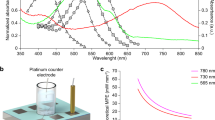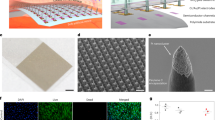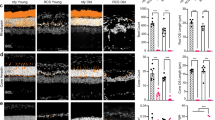Abstract
Photoelectric dyes, which absorb light and generate electric potential, have been shown to stimulate retinal neurons. Therefore, in the present work, a photoelectric dye was used to develop a retinal prosthesis to restore vision loss due to diseases, such as retinitis pigmentosa. The retinal prosthesis, referred to as a dye-coupled film, was prepared by chemically coupling the dyes to a polyethylene film surface. However, the amount of coupled dye decreased during an implantation test in a monkey’s eye. The dye consisted of a cation with photoresponsivity and Br−. Because thermal stability can be improved by anion exchange, we expected anion exchange to lead to stabilization of the chemical structure, resulting in improvement of the long-term durability of a retinal prosthesis. Therefore, the effects of exchanging Br− anions for PF6−, BF4−, and bis(trifluoromethanesulfonyl)imide (TFSI−) anions on the durability were investigated. The long-term durability of the dye-coupled films was found to be strongly related to the thermal stability of the photoelectric dye. The long-term durability of the dye-coupled film–PF6− and dye-coupled film–TFSI− improved by 637 and 215%, respectively, compared with that of the dye-coupled film–Br−.
This is a preview of subscription content, access via your institution
Access options
Subscribe to this journal
Receive 12 print issues and online access
$259.00 per year
only $21.58 per issue
Buy this article
- Purchase on Springer Link
- Instant access to full article PDF
Prices may be subject to local taxes which are calculated during checkout









Similar content being viewed by others
References
Gratzel M. Solar energy conversion by dye-sensitized photovoltaic cells. Inorg Chem. 2005;44:6841–51.
Hagberg DP, Marinado T, Karlsson KM, Nonomura K, Qin P, Boschloo G, et al. Tuning the HOMO and LUMO energy levels of organic chromophores for dye sensitized solar cells. J Org Chem. 2007;72:9550–6.
Alamusi MatsuoT, Hosoya O, Tsutsui KM, Uchida T. Vision maintenance and retinal apoptosis reduction in RCS rats with Okayama University-type retinal prosthesis (OURePTM) implantation. J Artif Organs. 2015;18:264–71.
Liu S, Matsuo T, Hosoya O, Uchida T. Photoelectric dye used for okayama university-type retinal prosthesis reduces the apoptosis of photoreceptor cells. J Ocul Pharm Ther. 2017;33:149–60.
Matsuo T. A simple method for screening photoelectric dyes towards their use for retinal prostheses. Acta Med Okayama. 2003;57:257–60.
Loewenstein JI, Montezuma SR, Rizzo JF III. Outer retinal degeneration: an electronic retinal prosthesis as a treatment strategy. Arch Ophthalmol. 2004;122:587–96.
Matsuo T, Morimoto N. Visual acuity and perimacular retinal layers detected by optical coherence tomography in patients with retinitis pigmentosa. Br J Ophthalmol. 2007;91:888–90.
Tamaki M, Matsuo T. Optical coherence tomographic parameters as objective signs for visual acuity in patients with retinitis pigmentosa, future candidates for retinal prostheses. J Artif Organs. 2011;14:140–50.
Tagawa T, Shimamura K. Observation of the internal lamellar structure in polyethylene films by nitric acid treatment and SEM technique. J Electron Microsc. 1980;28:314–5.
Uchida T, Ishimaru S, Shimamura K, Uji A, Matsuo T, Ohtsuki H. Immobilization of photoelectric dye on the polyethylene film surface. Mem Fac Eng. 2005;39:16–20.
Uji A, Matsuo T, Ishimaru S, Kajiura A, Shimamura K, Ohtsuki H, et al. Photoelectric dye-coupled polyethylene film as a prototype of retinal prostheses. Aritif Organs. 2005;29:53–7.
Uji A, Matsuo T, Uchida T, Shimamura K, Ohtsuki H. Intracellular calcium response and adhesiveness of chick embryonic retinal neurons to photoelectric dye-coupled polyethylene films as prototypes of retinal prostheses. Artif Organs. 2006;30:695–703.
Okamoto K, Matsuo T, Tamaki T, Uji A, Ohtsuki H. Short-term biological safety of a photoelectric dye used as a component of retinal prostheses. J Artif Organs. 2008;11:45–51.
Tamaki T, Matsuo T, Hosoya O, Tsutsui KM, Uchida T, Okamoto K, et al. Glial reaction to photoelectric dye-based retinal prostheses implanted in the subretinal space of rats. J Artif Organs. 2008;11:38–44.
Matsuo T, Uchida T, Takarabe K. Safety, efficacy, and quality control of a photoelectric dye-based retinal prosthesis (Okayama University-type retinal prosthesis) as a medical device. J Artif Organs. 2009;12:213–25.
Humayun MS, de Juan E Jr., Dagnelie G. The bionic eye: a quarter century of retinal prosthesis research and development. Ophthalmology. 2016;123:S89–97.
Humayun MS, Dorn JD, da Cruz L, Dagnelie G, Sahel JA, Stanga PE, et al. Interim results from the international trial of second sight’s visual prosthesis. Ophthalmology. 2012;119:779–88.
da Cruz L, Dorn JD, Humayun MS, Dagnelie G, Handa J, Barale PO, et al. Five-year safety and performance results from the Argus II Retinal Prosthesis System clinical trial. Ophthalmology. 2016;123:2248–54.
Stingl K, Bartz-Schmidt KU, Besch D, Braun A, Bruckmann A, Gekeler F, et al. Artificial vision with wirelessly powered subretinal electronic implant alpha-IMS. Proc R Soc B. 2013;280:1–8.
Stingl K, Bartz-Schmidt KU, Besch D, Chee CK, Cottriall CL, Gekeler F, et al. Subretinal visual implant Alpha IMS—clinical trial interim report. Vis Res. 2015;111:149–60.
Stingl K, Schippert R, Bartz-Schmidt KU, Besch D, Cottriall CL, Edwards TL, et al. Interim results of a multicenter trial with the new electronic subretinal implant alpha ams in 15 patients blind from inherited retinal degenerations. Front Neurosci. 2017;11:445–55.
Matsuo T, Uchida T, Yamashita K, Matsuo C, Kawakami Y, Hitomi T, et al. Novel disposable injector (OUReP Injector) tested in experimental aphakic eyes of rabbits for subretinal implantation of Okayama University-type retinal prosthesis (OUReP). Anim Eye Res. 2018;37:3–12.
Alamusi MatsuoT, Hosoya O, Tsutsui KM, Uchida T. Behavior tests and immunohistochemical retinal response analyses in RCS rats with subretinal implantation of Okayama University-type retinal prosthesis. J Artif Organs. 2013;16:343–51.
Alamusi MatsuoT, Hosoya O, Uchida T. Visual evoked potential in RCS rats with Okayama University-type retinal prosthesis (OUReP™) implantation. J Artif Organs. 2017;20:158–65.
Matsuo T, Uchida T, Yamashita K, Takei S, Ido D, Fujiwara A, et al. Vision evaluation by functional observational battery, operant behavior test, and light/dark box test in retinal dystrophic RCS rats versus normal rats. Heliyon. 2019;5:e01936–43.
Shirai H, Mandai M, Matsushita K, Kuwahara A, Yonemura S, Nakano T, et al. Transplantation of human embryonic stem cell-derived retinal tissue in two primate models of retinal degeneration. PNAS. 2015;113:E81–90.
Matsuo T, Uchida T, Sakurai J, Yamashita K, Matsuo C, Araki T, et al. Visual evoked potential recovery by subretinal implantation of photoelectric dye-coupled thin film retinal prosthesis in monkey eyes with macular degeneration. Artif Organs. 2018;42:E186–203.
Bini R, Bortolini O, Chiappe C, Pieraccini D, Siciliano T. Development of cation/anion “interaction” scales for ionic liquids through ESI-MS measurements. J Phys Chem B. 2007;111:598–604.
Blake DM, Moens L, Rudnicki D, Pilath H. Lifetime of imidazolium salts at elevated temperatures. J Sol Energy Eng. 2005;128:54–7.
Prescher S, Ghasimi S, Höhne P, Grygiel K, Landfester K, Zhang KAI, et al. Polyfluorene polyelectrolyte nanoparticles: synthesis of innovative stabilizers for heterophase polymerization. Macromol Rapid Commun. 2014;35:1925–30.
Zhao LN, Cai T, Zhang YX, Ye MT, Shang WJ, Liu D, et al. Synthesis, characterization and tribological evaluation of novel 1,4-diazabicyclo[2.2.2]octane based dicationic ionic liquids as efficient antiwear lubricant additives. Sci China Tech Sci. 2019;62:252–62.
Döbbelin M, Tena-Zaera R, Marcilla R, Iturri J, Moya S, Pomposo JA, et al. Multiresponsive PEDOT-ionic liquid materials for the design of surfaces with switchable wettability. Adv Funct Mater. 2009;19:3326–33.
Lee BS, Chi YS, Lee JK, Choi IS, Song CE, Namgoong SK, et al. Imidazolium ion-terminated self-assembled monolayers on au: effects of counteranions on surface wettability. J Am Chem Soc. 2004;126:480–1.
Uchida T, Nitta M, Kanashima S. Synthesis and light-induced surface potential observation of retinal prosthesis using polyethylene thin films immobilized with photoelectric dyes. J Photopolym Sci Technol. 2015;28:261–7.
Matsuo T, Sakurai M, Terada K, Uchida T, Yamashita K, Tanaka T, et al. Photoelectric dye-coupled polyethylene film: photoresponsive properties evaluated by kelvin probe and in vitro biological response detected in dystrophic retinal tissue of rats. Adv Biomed Eng. 2019;8:137–44.
Baikie ID, Smith PJS, Porterfield DM, Estrup PJ. Multitip scanning bio-Kelvin probe. Rev Sci Instrum. 1999;70:1842–50.
McNab J, Sandborg A. The EDAX editor. Interactive Periodic Table of Elements. AMETEK Inc. Vol. 14. 1984. p. 37. https://www.edax.com/resources/interactive-periodic-table. Accessed 15 Feb 2021.
Okawa H, Sampath AP, Laughlin SB, Fain GL. ATP consumption by mammalian rod photoreceptors in darkness and in light. Curr Biol. 2008;18:1917–21.
Tamada Y, Ikada Y. Effect of preadsorbed proteins on cell adhesion to polymer surfaces. J Colloid Interface Sci. 1993;155:334–9.
Acknowledgements
This work was supported by JSPS KAKENHI Grant Number JP19J13826. The authors are grateful to Prof. Kenji Tsuruta, Okayama University, and Dr. Satoshi Ohmura, Hiroshima Institute of Technology, for valuable discussions.
Author information
Authors and Affiliations
Corresponding author
Ethics declarations
Conflict of interest
The authors declare no competing interest.
Additional information
Publisher’s note Springer Nature remains neutral with regard to jurisdictional claims in published maps and institutional affiliations.
Supplementary information
Rights and permissions
About this article
Cite this article
Yamashita, K., Tanaka, T., Matsuo, T. et al. Development and chemical properties of retinal prostheses using photoelectric dyes coupled to polyethylene films with various anions to achieve high durability. Polym J 53, 719–729 (2021). https://doi.org/10.1038/s41428-021-00468-0
Received:
Revised:
Accepted:
Published:
Issue Date:
DOI: https://doi.org/10.1038/s41428-021-00468-0



